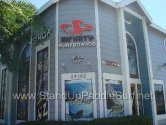Video with Steve Boehne owner of Infinity Surf (Ku Ku Hoe) and master stand up paddle surfboard shaper
In my visit with Steve Boehne, master stand up paddle surf board shaper and owner of Infinity Surf and Ku Ku Hoe, Steve shared some very insightful tips on how to best choose a stand up paddle board and things to consider. Check out this video to hear Steve first hand.

(click thumbnail to launch video)
00:00
Evan Leong: It’s funny because I start off on big boards too. These things look huge until you get them in the water. And then, “Oh, it’s not that big.”
Steve Boehne: You know, the thing that everyone has to remember – if you’re already an experienced stand up paddle surfer you already know what you’re capabilities are. You know how big a board you need. You know what’s hard for you, what’s easy. So it is easy to decide what you board you want. If you’re a beginner, you really have to pay attention because if you weight 230 pounds you need a big wide board, and if you’re 170 pounds, you don’t need it – and it’s stupid to have it. It’s just too big to carry and it’s hard to maneuver. And you have to make sure – if you’re a big guy you don’t want to buy a board that the small guy is going to use. So we make the boards custom. We make it the right width, the right thickness, the right length for each guy; and we do some really big boards and we do some small boards too.
00:55
Evan Leong: So you’re not looking in to doing production kind of boards; most just purely custom.
Steve Boehne: I did two Surftech models. So there’s two stand up boards coming out – an 11-foot noserider and a 10-foot carving board. I did both of them relatively thick for say a big guy.
01:11
Evan Leong: Like 4 ½ or five or what?
Steve Boehne: The 10-foot carving is 4 7/8 and you know like the C4’s are about 4 ¼ or 4 3/8.
Evan Leong: It’s 3 7/8 I think.
Steve Boehne: 3 7/8, yeah.
Evan Leong: Yeah, there’s 3 7/8, 4, and just maybe 4 ¼.
Steve Boehne: You know you get a guy that’s a small guy, 175 pounds, when he gets on that it’s fine but if the guy weighs 215, 220 and he wants to ride 10-foot board, he’s going to have a problem. The board is sunken and it’s going to be tippy. So the two that I did, I knew that those boards are available. What I did is a 10-foot carving board that is a high-performance board, a 200-pound guy can get on it and paddle great. The same with the 11-footer.
01:54
Evan Leong: Do you have a custom one that is kind of similar?
Steve Boehne: Yeah. This board right here is identical in the shape to the Surftech that I did. See how the tail is pulled in narrow.
Evan Leong: Yeah, really narrow tail, huh?
Steve Boehne: Yes. So you have 28-inches right here and then a very narrow tail and that allows you to carve your bottom too with a lot of power.
02:19
Evan Leong: Is it kind of tippy then or what?
Steve Boehne: No, it’s not because the stability comes from the middle—that’s where you’re standing. You get your 28-inches in the middle but you pull the tail in and you did a big drop in a big wave, you can step back and cut a turn, you can do a very powerful turn with a narrow tail.
02:36
Evan Leong: And then the rail – same as the other one – it’s actually a little bit rounder on the bottom, huh?
Steve Boehne: No, it’s a tucked-edge rail and that’s also very responsive.
02:46
Evan Leong: So tucked-edge rail means what?
Steve Boehne: The rail comes around like this and then it comes in, tucked in under and then it has an edge. And for big boards, it’s a more responsive rail.
Evan Leong: Is that what they call downturn rail?
Steve Boehne: Yeah, of course. It’s the same. A downturn rail is the same thing. It’s down, cuts underneath and then it has an edge.
03:10
Evan Leong: And then there’s slight V on the…
Steve Boehne: I use a lot of V.
Evan Leong: And the V is the roundness, right?
Steve Boehne: The V – if you put a straight edge here you can see the V, but you need a straight edge to see it.
03:22
Evan Leong: And the front part is completely flat.
Steve Boehne: It’s flat.
Evan Leong: Pretty nice. How much does a board like that cost?
Steve Boehne: This one is about $1,500 USD.
Evan Leong: About market, pretty much average.
Steve Boehne: Uh huh.
Evan Leong: And then this is the drain plug.
Steve Boehne: That’s the air vent.
03:41
Evan Leong: Oh, air vent. Air vent, sorry. I’m used to kayaks, drain plug. That’s kind of sweet. What’s the most popular you’re selling then? Or it depends because of guys’ size.
Steve Boehne: Yeah, it depends. The experienced guys, the guys getting their second boards, a lot of times will get this one. And the first time guy should get a big board, 11 feet.
04:10
Evan Leong: So a lot of women you’re getting to buy these or mostly men?
Steve Boehne: You know, a lot of times the girls, they like to use their boyfriend’s board or husband’s board and so a lot of times they don’t get their own. But if they really get in to it then they get their own and they can get much smaller boards – narrower and thinner.
04:29
Evan Leong: So mostly, your boards are based on this design with the narrow tail and much more surfy kind of a feeling than cruiser, right?
Steve Boehne: Yeah.
Evan Leong: Cool. I notice on this one the nose is a little bit, looks like a little bit wider, maybe more of a…
Steve Boehne: Yeah, that is a slightly different tip of a nose…
Evan Leong: And then this one… so you can see. This one looks much more surfier, carried out kind of surfy. This is a little bit…
Steve Boehne: This one is a quad and this is made for smaller waves so it does have quite a wider fin right here. You see how it pulls in and the tip of the tail is narrow so it has a lot of curve right here.
05:08
Evan Leong: So what’s the deal on quads then, because normally when I see quads they’re like fish quads?
Steve Boehne: You know, any kind of quad – you turn a board and you bank them like this, the fins out on the rail give you a lot of power and so they’re like more powerful turning. But the board is a little bit loose, it’s a little bit squarely sometimes and you have to be kind of a good surfer to be used to a quad because it always want to turn and doesn’t want to go straight.
05:39
Evan Leong: So not really beginner-ish kind of board, right?
Steve Boehne: If the guy is a good surfer then it’s ok to be a quad the first time. But if he’s not a surfer, a quad may be crazy for him. This board here is polyester; it’s not epoxy. It doesn’t have an air vent because it’s polyester.
06:01
Evan Leong: Is it heavy?
Steve Boehne: But it’s heavier. It’s just like (____). So it weighs maybe 8 ounce more.
06:08
Evan Leong: Are you finding that the heavier boards are more stable in the water or what?
Steve Boehne: No, I don’t think so. The stability comes from the width. If the board is wide, it’s more stable. If it’s narrow and thin then it’s less stable. Now it is true, the lighter epoxy boards will turn faster because they change directions because they are lighter.
Evan Leong: The Lairds look so big but they’re really not when you get on them in the beginning. In the beginning, you’re like, “Oh these things are so huge” and you get on them and it’s like, “It just needs to be bigger.”
Steve Boehne: The thing about the Laird it’s a great board for just learning and for paddling because paddling is very stable but it does not have any V in the bottom. It has a concave. So when you surf on it, it surfs kind of stiff. It doesn’t really carve the turns and it doesn’t surf too well. But it’s the paddling that’s good.
07:04
Evan Leong: Did we leave anything out? Anything in the boards or what makes it special or what things are different or anything like that.
Steve Boehne: I think the main thing, the most important thing to any body who wants to get a stand up board – if they’re just getting their first board – they have to make sure that the width of the board, the thickness and the length are right for them. If it’s a big guy he does not want to buy a small board that a little guy would use – it would be miserable, he can’t keep his balance. And so all our boards are all the different thickness, different width for that individual guy. If he comes and get an inventory board, he has to pick the right one. He has to get the one that is big for him. If he a small guy or he is already a good surfer or he is young, then he can get a smaller board. You have to use the right size board. You just don’t get some popular board. To me, if a guy weighs 175 pounds it would be foolish to buy a Laird board. It’s just too big for any reason for a guy that size to have.
08:06
Evan Leong: I think the Surftech ones have some smaller ones too coming, right?
Steve Boehne: I think they most certainly do. They have two from me and you bet, they’re going to come out with much more. Yeah.
Evan Leong: Cool. And what else you got here? You got short boards, paddle boards. What’s that? A soft top? Cool. Ok, thanks.
 Steve Boehne owner of Infinity Surf (Ku Ku Hoe) and master stand up paddle surfboard shaper [8:35m]: Download
Steve Boehne owner of Infinity Surf (Ku Ku Hoe) and master stand up paddle surfboard shaper [8:35m]: Download Video with Steve Boehne owner of Infinity Surf (Ku Ku Hoe) and master stand up paddle surfboard shaper [8:35m]: Download
Video with Steve Boehne owner of Infinity Surf (Ku Ku Hoe) and master stand up paddle surfboard shaper [8:35m]: Download























Steve, I am 280 lbs, but will shed lbs fast once back in the water. Had both knees replaced and gained some lbs. Been surfing all my life, 56 now, never paddle board. I think I would like an 11′ 30″-31″ 4.25″-4.75″ that I can use in the surf. Please respond.
Hawk